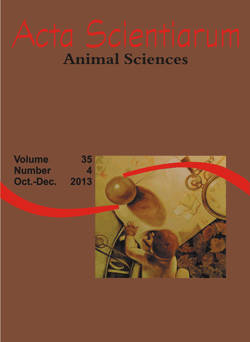<b>Pasture height at the beginning of deferment as a determinant of signal grass structure and potential selectivity by cattle</b> - doi: 10.4025/actascianimsci.v35i4.20421
Abstract
Current experiment identified the height of signal grass {Urochloa decumbens (Stapf) R. D. Webster cv. Basilisk [syn. Brachiaria decumbens Stapf cv. Basilisk]} at the beginning of deferment that provided an appropriate pasture structure and potential selectivity by cattle on deferred pastures. Four pasture heights at the beginning of deferment (10, 20, 30 and 40 cm) and two forage samples (available on pasture and simulated grazing) were studied. The experimental design was set in completely randomized blocks, with two replications, in a split-plot arrangement. Higher percentage of live leaf blades and lower percentage of live stems and senescent forage were recorded in the forage sample from simulated grazing. The increase in pasture height increased the percentage of senescent forage and reduced the percentage of live leaf blades in forage samples. Pasture height at the beginning of deferment did not affect the potential selectivity index by cattle for the percentage of live leaf blade. The potential selectivity index varied quadratically for the percentage of live stems and increased linearly for the percentage of senescent forage with pasture height. A 10-to-20 cm reduction in pasture height at the beginning of deferment improved the structure of deferred signal grass and optimized selectivity by cattle.
Downloads
DECLARATION OF ORIGINALITY AND COPYRIGHTS
- I Declare that current article is original and has not been submitted for publication, in part or in whole, to any other national or international journal.
The copyrights belong exclusively to the authors. Published content is licensed under Creative Commons Attribution 4.0 (CC BY 4.0) guidelines, which allows sharing (copy and distribution of the material in any medium or format) and adaptation (remix, transform, and build upon the material) for any purpose, even commercially, under the terms of attribution.
Read this link for further information on how to use CC BY 4.0 properly.








































